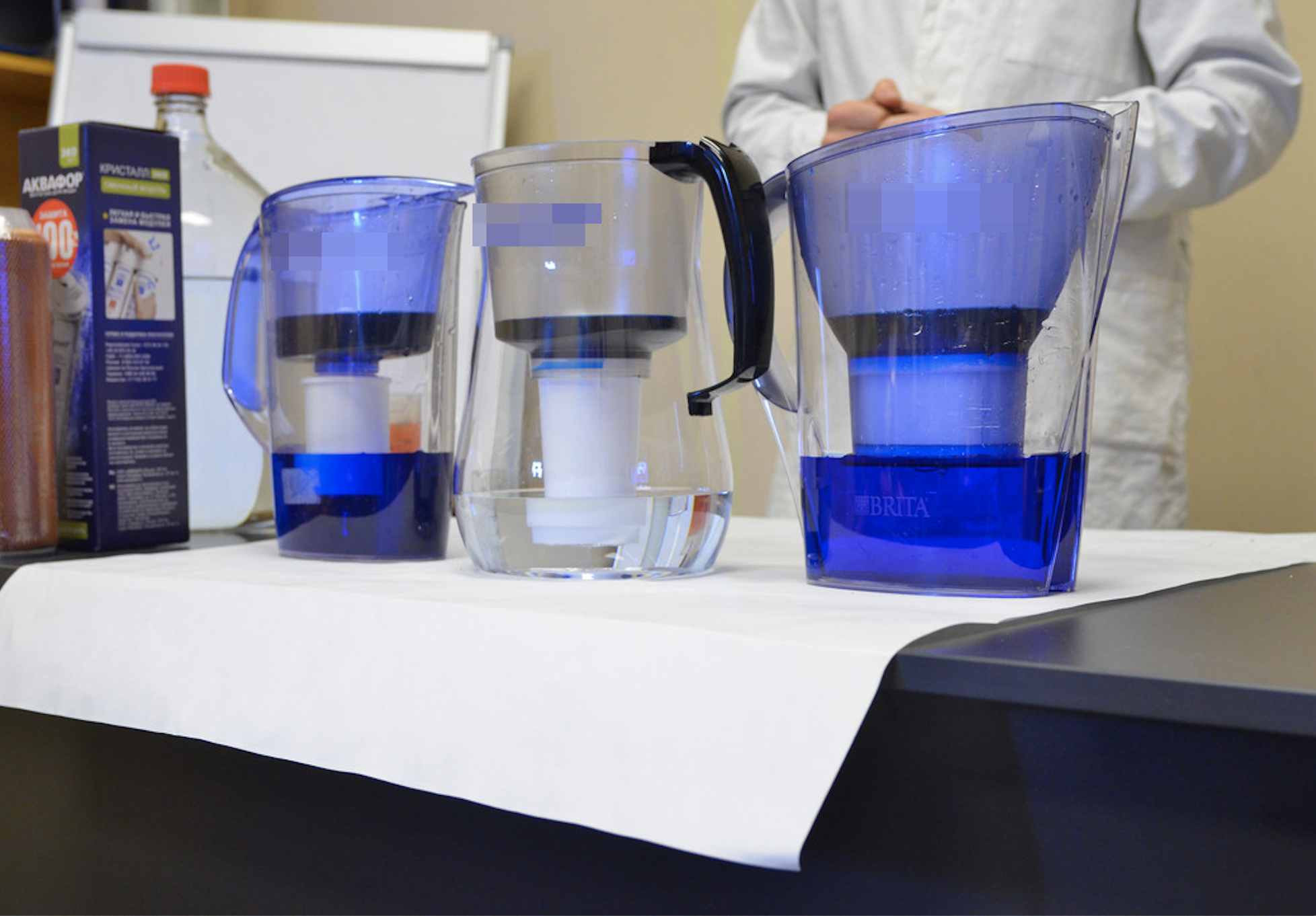
Not so long ago, my wife and I finally got our own housing, and I was puzzled by the question of how smarter and more economical to organize additional water purification at home. Since I work in a company that is also involved in chemical research, it turned out to be almost complete laboratory tests of several filter models. The testing and comparison process turned out to be interesting, so I decided to share these observations and conclusions here.
Why even clean the water?
Municipal water supply (water utility) cleans the water as follows. Water is taken from a pond or well, and then a coagulant is added to it - a substance that collects small particles of impurities into large flakes. Then mechanical filtration is carried out, which removes these flakes from the water. Next comes the bactericidal treatment - chlorination.
The resulting water meets sanitary standards. This means that it is not toxic and not dangerous to health in the short term. That is, the MPC (maximum permissible concentration) of harmful substances in such water is NOT exceeded. Yes, the substances there MAY be, but in the quantities permitted by the standard. To be completely clear: this water can be drunk without the risk of dying immediately after drinking. But such water may contain chlorine residues, pesticides and other organic matter. After passing through the pipes, the water collects colloidal iron, rust and heavy metal ions. All this can be part of both black and non-ferrous alloys, which make pipes, faucets, fittings and other plumbing fixtures. Immediately it does not harm, but in the long run, the use of such water will definitely affect health. Therefore, after-treatment of water is an important and necessary thing. Especially if there are children in the house (my wife and I are planning to get it soon).
Practice
To find out how the filters of different manufacturers differ from each other, and what filter how to clean, my colleague and I conducted a small “investigative” experiment. You can repeat it even at home with the filter that you have at home. True, you have to spend a little money on the purchase of reagents - there are sites that sell equipment and materials for chemistry lessons, there you will find everything. In this regard, I was lucky with the work - it turned out to agree with the laboratory and get reagents there.
Which pitcher is better?

I used jug filters all the years that I roamed in rented apartments. Honestly, the difference between the filter-jugs of different brands has never been particularly seen and did not even think that it is in principle: all of them, plus or minus, cost the same and plus or minus look the same. Always chose based on the price tag, volume and color of the cap. Therefore, on the test of high hopes to get different results was not.
For the experiment, we chose the three most popular, judging by the reviews on the Internet, the filters: “Aquaphor Provence” with A5 module (cartridge price - 240 rubles), “Barrier” with “Standard 4” module (cartridge price 210 rubles) and “Brita Marella” "With the module" Makstr Universal "(cartridge price 350 rubles).
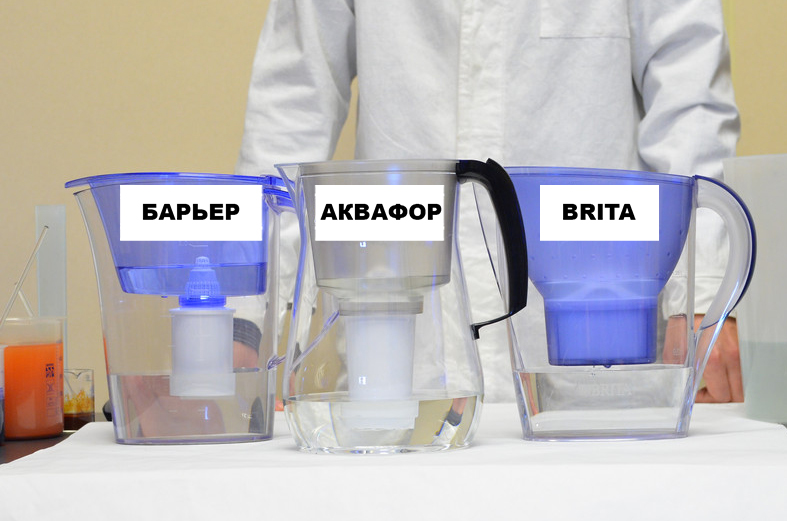
Everything is fair: completely new filters were tested. For everyone just in case a spare cartridge was purchased.


Before the tests, each jug cartridge was washed with about a liter of water - according to the instructions, this is the only way they give out the full cleaning power, otherwise the experiment will not be indicative.
First of all, it was decided to check how the jugs deal with pesticides, toxins and other organic matter. The issue is important because, as mentioned above, the water utility does not remove most organic pollutants from water.
To the naked eye and to taste, the presence of pesticides, toxins, organics and organochlorine in water cannot be determined. Therefore, in our experiment, their role was played by the dye “Methylene blue”, which even at a low concentration (10-50 μg / l) paints water in a radical blue color.
In GOST 4453-74, this dye is used to determine the sorption capacity of activated carbon, that is, the ability of coal to bind organic substances contained in water. It is important for us that methylene blue, firstly, is similar in chemical structure to pesticides and toxins, and secondly, it is perfectly visible even in low concentrations without any devices.

The dye is sold in pet stores - it is used to disinfect aquariums, and is cheaper than 50 rubles per bottle. If you want to test your home filter in the same way as we did - this is the easiest and cheapest way.
So, we dissolved the contents of the vial (50 ml) in 6 l of water and obtained a solution with a concentration of approximately 50 mg / l. The resulting dark blue liquid was passed through the filters. The results were evaluated visually as follows: if the water is completely transparent, the filter copes well with organic pollutants. If the water at the outlet is blue or blue, respectively, the pesticides would also have missed such a filter. The darker the blue, the lower the cleaning percentage.

You can evaluate it yourself on the photo: cleaning is close to 100% - only at Aquaphor. He alone gave visually clear water. Percentages of 80-85% for Barrier and Brita, which, by the way, is more expensive than the other participants combined.
Then they washed the pitchers with water from the blue and immediately began to check the effectiveness of the same cartridges in the fight against rusty water. For clarity, we used a suspension of iron (III) hydroxide at a concentration of 100 mg / l (for iron). The resulting solution has more than three hundred times the maximum permissible concentration of iron in water.
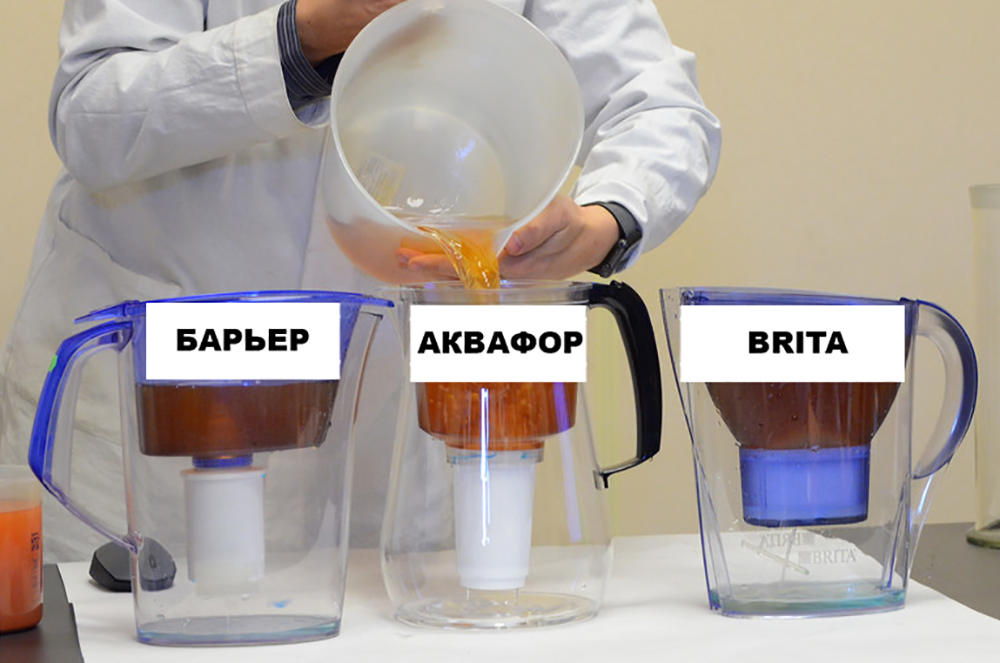
In this experiment, Brita stood out: water passed through the filter one and a half times faster than through Aquaphor and Barrier. For a normal user, such a high speed of “cleaning” is a big plus. Just scored - and you can already drink. That's just, as it became apparent from the experiment, quickly does not always mean good!
Results were also evaluated visually. According to the results of the rust test, the “winner” again became “Aquaphor” - it gave completely transparent water at the outlet, that is, it filtered out almost 100% of the suspension. The second place in “Barrier” ”(~ 85%), and the worst part was removed from the water by the most expensive participant of our experiments,“ Brita ”(~ 80%).

These results are visible without any measurement of concentrations - just the water looks completely different. Such different results for similar (seemingly) in construction and principle of operation of filters surprised us. As I said, initially I used to think that they all work the same way. To find out the reason for such strong differences in the effectiveness of water purification, we decided to open the cartridges and study the sorbent. Maybe “Aquaphor” has more of it or it has a completely different composition?

We cut the cartridges involved in the test and examined the contents. The inner world of "Barrier" and "Brita" was identical. Black granules - activated carbon, gray granules - ion exchange resin. Brita has smaller granules - hence the high speed and low quality of mechanical filtration. Despite the fact that the filter is the most expensive, the sorbent in it is the least.
Against the background of the “Barrier” and “Brita” scattered in a shapeless pile, the sorbent from the Aquaphor cartridge stays awake. The granules of coal and tar in this filter retained the shape of the Easter cake, and the granules are two times smaller in size than in Brita and Barrier.
These pellets hold thin yellow fibers as a single composite. Something looks like a potted earth with a plant — if you have ever planted flowers, you have seen how a tangle of thin roots holds the ground.

Fiber, as it turned out, is the special material Aqualen-2. The manufacturer’s website states that this is a unique in-house development of the Aquaphor Scientific Research Institute, a special fiber that (further quotes from the site)
“selectively absorbs heavy metal ions and allows silver ions to remain in the active ionic form in the sorbent, as well as retains the sorbents granules, not allowing to form channels through which water passes without purification. "
The diagram above (also taken from the Aquaphor site) shows how the sorbent works in different filters. In conventional cartridges, where activated charcoal and tar are packed in an indiscriminate heap, water forms channels between the granules and passes through them very quickly with minimal or no cleaning. Aqualen-2 fights the “channel effect” and allows using a smaller sorbent. The “root system” in the “Aquaphor” cartridge distributes water over a large area, so the sorbent has time to retain more pollutants. Clear water in a jug is a direct confirmation of this.

The photo of the disassembled cartridge shows that the blue dye solution did not pass even a third of the sorbent block, while the “Barrier” and “Brita” sorbents were painted completely, and at the same time they missed a part of methylene blue into the tank for purified water.
Why other manufacturers do not even try to do something like that, but use the old technology of filling the sorbent in a shapeless pile? In search of additions to the experiment, I again went through the Internet. The Brita jugs have an interesting design, very beautiful creative advertising. The content of the filters intelligible information could not be found. Coal and ion exchange resin is a classic that has not changed for more than 30 years. The “barrier” clearly shows the cartridge in section, but the experiment says that the effectiveness of this design also has some questions. "Aquaphor" does not skimp and invests in the development. They did not even expect to find their own research institute and investment in know-how worth millions of dollars from a Russian manufacturer.
Why, apart from “Aquafor”, few bother with the development of technology - one can only guess. First, it is difficult and expensive. Secondly, it is also a thankless task. With more or less normal water from the tap, the presence of pollution with the naked eye cannot be seen in it - the solutions of most toxins and pesticides are in fact colorless, and not blue as the dye in our experiment. Rust in such a strong concentration occurs only during accidents or in the "morning discharges." Stress tests like ours none of the usual buyers of filters will not conduct. That is, a normal person, like my mother, does not recognize any differences in the quality of cleaning between “Brita” and “Aquaphor” in life. And in the store on the shelf all the filters are generally the same, and people choose by price, volume and color of the cap. So why should manufacturers spend on development - is it logical?
However, enough of the lyrics - let's continue to compare the filters.
Compare stationary filters with the stated bactericidal
Stationary filters, as a rule, remove contaminants much more effectively than jugs: the presence of water pressure allows using a more dense sorbent, as well as filters based on hollow fiber or reverse osmosis membranes. Manufacturers of many stationary water purifiers claim that their filters make the water cleaner than boiled - they can remove not only pesticides and rust from the water, but also bacteria and parasite cysts. For jug filters that have been tested before, this is not possible.
In general, stationary filters, although more expensive, are better (at least for Russian realities). Readers who have their own housing or sufficiently compliant landlords, definitely recommended to spend money and put a stationary filter, and not expect to do with a jug. But which filter under the sink to choose?
It is unlikely that you will be able to compare stationary filters at home: firstly, buying several different filters is expensive, and secondly, it is also quite difficult to mount them.
In order not to waste time on installing filters under the sink, we built a tricky "simulation" of the aqueduct right in the laboratory. An electric pump pumps water at a pressure of about 3.5 atmospheres from a large tank with raw water to two filters at once. The water that has passed the purification in the filters is collected in two smaller glass containers.
The participants of the new comparison were two filters, which have declared the removal of 100% of bacteria from the water. In the case of microbiological contamination, half-measures are unacceptable: either the filter removes 100% of all bacteria, or it is 100% ineffective. The thing is that, unlike pesticides, toxins, rust, hardness salts and other pollutants, living organisms multiply. So even if the filter leaves 0.01% of bacteria in the water - after a while this tiny amount of microorganisms will multiply to a volume of 100%.
So, filters with a “bactericidal” function: in the left corner of the ring “Aquaphor Crystal Eco” with a K7B cartridge (4,950 rubles), in the right corner of the ring - there was a “Geyser” with a cartridge “Aragon-2” (4,790 rubles).
…………………. THE FURTHER TEXT WAS CHANGED AFTER POSTING .........................
I was forced to change the original text of my post at the request of an employee of the company "Geyser".
The comparison yielded extremely interesting results and conclusions, gathered a lot of comments, questions and clarifications in a personal (thanks for your interest!).
But two weeks later, a representative of the brand “Geyser” came to me in PM and accused me of bias and injustice of conclusions. And after some discussions, they ultimately demanded that I remove the description of the test results of their filter from my post, threatening to put pressure on the law and get the entire post removed. Ugly, in general, the situation.
In PM, I asked a representative a simple question:
How does the "Geyser" with the "Aragon" cartridge filter water from bacteria and viruses?
a) method of mechanical filtration (just physically does not let bacteria)? If yes, then why in my test particles, 1 micron in size (bacteria in size) pass through the filter?
b) or is it still a chemical filtration method? If so, what substance bacteria and viruses are actively killed? After all, we are looking at point a) particles 1 micron in size through the filter still leak out - this is clearly shown by our test.
Unfortunately, after a long, in a few days, personal correspondence, I did not receive any answers to these questions from a Geyser representative.
But, in any case, I delete the results of our testing of the filter "Geyser" with the cartridge "Aragon" from the post - I do not want to provoke a conflict.
Nevertheless, I consider it necessary to note that the test results seemed to me (and to a large number of readers) worthy of interest. And therefore I will continue to understand the question further. And I’ll think about how to convey unbiased information about the real effectiveness of the Geyser filters to interested consumers.
In the meantime, I suggest that you familiarize yourself with the second part of the results of our test - the results of the Aquaphor filter.
…………………. END OF THE CHANGED FRENCH OF THE ORIGINAL POST …………………
We decided not to breed hazardous biological contamination, so we decided to use a hematite suspension, a mineral whose particles are comparable in size to bacteria (approximately 1 micron), as a system for testing. A suspension of hematite at a concentration of 0.5 g per liter has a rich carrot color - if the filters do not cut off the particles, we will immediately see that the water will be yellow.
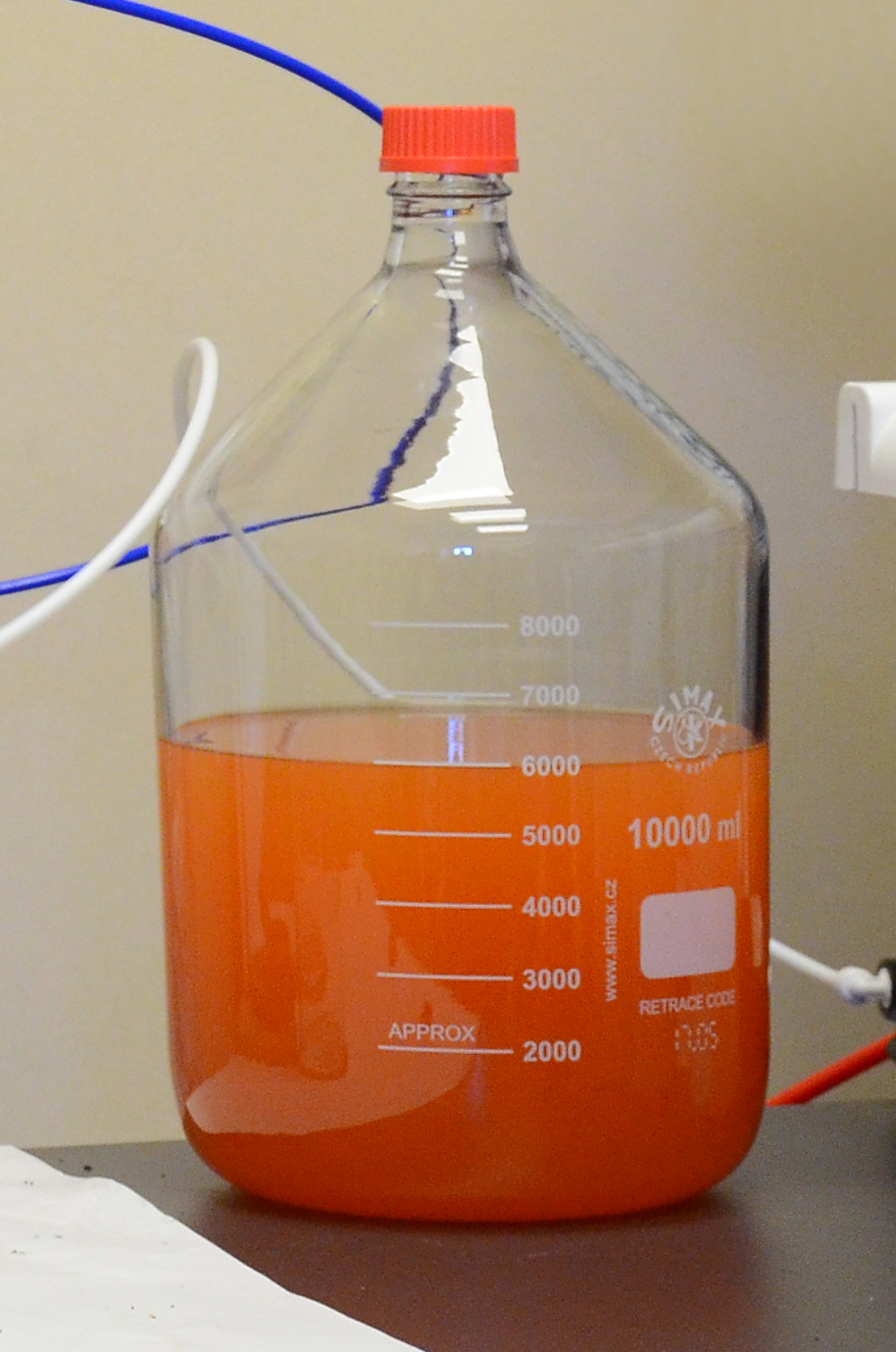
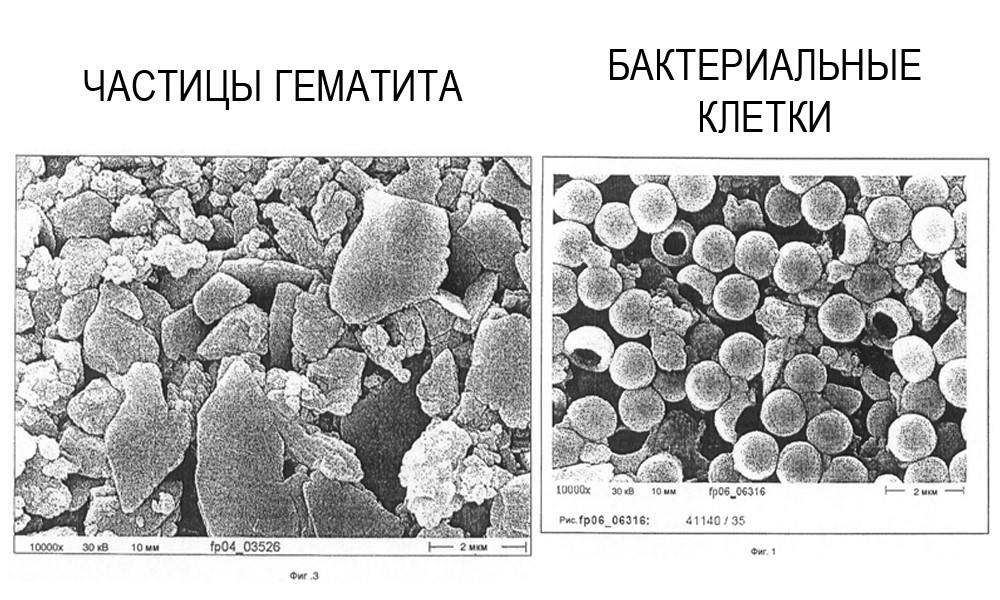
"Aquaphor" with a K7B cartridge gave clear, clean water. Hematite particles remained in the filter - the same fate would have waited for bacteria.
The test report "Aquaphor" ECO is included in
the instrument manual . According to the protocol, due to the use of the hollow fiber membrane, the filter cuts off 100% of the bacteria. The manufacturer’s website indicates that the membrane retains the smallest particles as small as 0.1 micron.
findings
In the course of our tests, Aquaphor filters turned out to be the most effective and interesting for studying. The domestic manufacturer quite unexpectedly for us, significantly bypassed rivals in the quality of water purification: in all tests, its filters produced clear, transparent water. As far as we have understood the topic, the effect was achieved due to the company's own developments. For example, the patented fiber Aqualen-2 made the filter jug sorbent much more efficient and extended its service life.
Genuinely disappointed the eminent European brand "Brita": it turned out that in the case of filters of this brand, the overpayment goes solely for European origin and a loud popular name. The Germans managed to save even on the filler for cartridges, because of which their pitcher showed the weakest results.
In my own kitchen, I eventually installed the Aquaphor Crystal ECO. And the parents brought the Aquaphor Provence to the country. Instead of Brita, who they had before ...
Thank you for mastering! I did not think that the post will turn out so verbose. And this I still cut out a lot. Write in the comments if you need any details. We still have all the filters that were used for the test, and there is an opportunity to once again look into the laboratory - so I can check or show something else if anyone is interested.
UPD: Many here accuse me of bias and anti-science.
The fact that the tests are devoid of deep chemical component. So, I found a 5-year-old video on YouTube, where a Pole Daniel Hapu compares pitchers in more detail and professionally.
And there Akvafor is also one step ahead.
Enjoy!